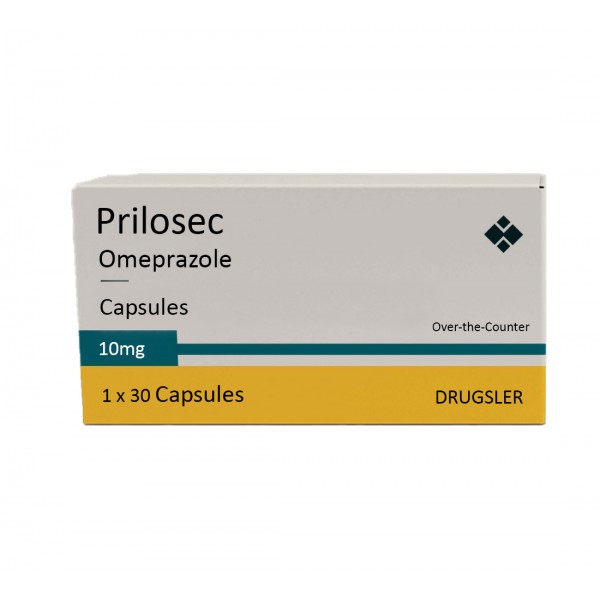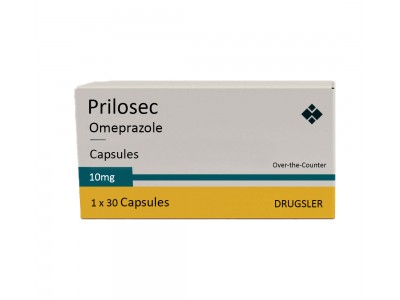What is Prilosec (Omeprazole)?
Prilosec, with the generic name omeprazole, is a medication commonly used to treat conditions caused by excess stomach acid. These conditions include gastroesophageal reflux disease (GERD), stomach ulcers, and Zollinger-Ellison syndrome. Prilosec belongs to a class of drugs known as proton pump inhibitors (PPIs), which work by reducing the amount of acid produced in the stomach. It is available both over-the-counter and by prescription. For over-the-counter use, it is typically used for the short-term treatment of frequent heartburn that occurs two or more days per week, with a treatment course generally lasting 14 days. Prescription doses may vary and are tailored to treat more severe conditions under medical supervision.
Omeprazole works by inhibiting the enzyme in the stomach lining responsible for acid production, thereby lowering the acidity in the stomach. This reduction in stomach acid helps heal acid damage to the stomach and esophagus, prevents ulcers, and may prevent cancer of the esophagus. It is usually taken before meals, and the timing of the dose can be crucial for its effectiveness. Potential side effects of Prilosec include headaches, abdominal pain, nausea, diarrhea, vomiting, and gas. Long-term use of PPIs like Prilosec has been associated with an increased risk of certain adverse effects, such as vitamin B12 deficiency, bone fractures, kidney disease, and infections like Clostridium difficile.
Despite these potential risks, Prilosec remains a widely used and effective treatment for managing acid-related disorders. Patients are advised to follow their healthcare provider's recommendations and report any persistent adverse effects or concerns while using the medication.
What is Prilosec (Omeprazole) used for?
Prilosec, or omeprazole, is used to treat various conditions associated with excessive stomach acid production. It is commonly prescribed for gastroesophageal reflux disease (GERD), a condition where stomach acid frequently flows back into the esophagus, causing irritation and heartburn. Prilosec helps alleviate symptoms and promotes healing of the esophagus. It is also used to treat stomach and duodenal ulcers, reducing stomach acid to facilitate healing and prevent further damage. In addition, Prilosec is effective in managing Zollinger-Ellison syndrome, a rare condition characterized by tumors in the pancreas or duodenum that cause the stomach to produce too much acid.
Prilosec is often used for the short-term treatment of frequent heartburn occurring two or more days per week. For this purpose, it is typically taken over a 14-day course. The medication works by inhibiting the enzyme in the stomach lining responsible for acid production, which helps reduce acidity and alleviate symptoms. This makes it useful not only for treating active ulcers and GERD but also for preventing ulcer recurrence and protecting the stomach lining in patients taking nonsteroidal anti-inflammatory drugs (NSAIDs).
Prilosec's effectiveness in reducing stomach acid makes it beneficial for a variety of acid-related conditions. By lowering acid levels, it helps heal damage to the stomach and esophagus, prevents ulcers, and reduces the risk of esophageal cancer in individuals with chronic acid reflux. The medication is typically taken before meals, and proper timing can enhance its efficacy. Despite its benefits, long-term use of Prilosec should be monitored by a healthcare provider due to potential risks such as nutrient deficiencies and an increased likelihood of certain infections.
What should you know before taking Prilosec (Omeprazole)?
Before taking Prilosec (omeprazole), it is important to be aware of several key considerations to ensure its safe and effective use. Firstly, inform your healthcare provider about any allergies you have, particularly to omeprazole or other proton pump inhibitors, as allergic reactions can be serious. Discuss your medical history, especially if you have liver disease, as Prilosec is metabolized in the liver and may require dosage adjustments or closer monitoring.
Understanding potential drug interactions is crucial. Omeprazole can interact with certain medications, including blood thinners like warfarin, antifungal drugs like ketoconazole, and antiretrovirals for HIV. These interactions can affect how well Prilosec or the other medications work, and may increase the risk of side effects. It’s important to provide a complete list of all the medications, supplements, and herbal products you are taking to your healthcare provider.
Pregnant or breastfeeding women should discuss the risks and benefits of using Prilosec with their doctor, as the effects on the unborn baby or nursing infant are not fully known. Additionally, inform your doctor if you have any symptoms of a serious underlying condition, such as unintentional weight loss, difficulty swallowing, persistent vomiting, or blood in vomit or stool, as these could indicate a more serious condition that needs different treatment.
Long-term use of Prilosec has been linked to certain health risks, such as vitamin B12 deficiency, bone fractures, and kidney disease. Therefore, it is generally recommended for short-term use unless advised otherwise by your healthcare provider. Regular monitoring and follow-up appointments may be necessary if you are on prolonged therapy.
Lastly, adhere to the prescribed dosage and timing, usually taken before meals, to maximize its effectiveness. Do not take more than the recommended dose, and consult your healthcare provider before stopping the medication, even if you feel better. This ensures that your condition is properly managed and helps prevent potential complications.
How to take Prilosec (Omeprazole)?
Taking Prilosec (omeprazole) correctly is important to ensure its effectiveness and minimize potential side effects. Prilosec is typically taken once daily before a meal, often before breakfast, unless otherwise directed by your healthcare provider. The medication should be taken at the same time each day to maintain consistent levels in your body. Swallow the capsule or tablet whole with a glass of water; do not crush, chew, or split it, as this can affect the way the medication is released and absorbed in your body.
If you are using the over-the-counter version of Prilosec for heartburn, follow the instructions on the package. Generally, it is recommended to take one pill daily for 14 days. If your symptoms persist or return soon after completing the course, consult your healthcare provider. For prescription omeprazole, your doctor will determine the appropriate dosage and length of treatment based on your specific condition.
For individuals who have difficulty swallowing capsules, Prilosec is available in different forms, such as a delayed-release capsule that can be opened and sprinkled on applesauce, or an oral suspension. If using the oral suspension, mix it with water as directed and take it immediately. Ensure that you use the correct amount of water and stir the mixture well.
Avoid taking Prilosec with other medications that also reduce stomach acid, such as antacids, without consulting your doctor, as this can alter its effectiveness. If you miss a dose, take it as soon as you remember unless it is almost time for your next dose. In that case, skip the missed dose and resume your regular schedule. Do not take a double dose to make up for a missed one.
While taking Prilosec, follow your healthcare provider’s advice regarding diet and lifestyle modifications that may help manage your condition. Keep all follow-up appointments to monitor your progress and report any persistent or worsening symptoms to your doctor. By adhering to these guidelines, you can effectively manage your condition and maximize the benefits of Prilosec.
Interactions of Prilosec (Omeprazole)
Prilosec (omeprazole) can interact with various medications, which may affect its efficacy or increase the risk of adverse effects. One of the primary interactions is with blood thinners like warfarin. Omeprazole can increase the levels of warfarin in the blood, heightening the risk of bleeding. Close monitoring of blood clotting times and potential dose adjustments may be necessary.
Prilosec also interacts with certain antifungal medications, such as ketoconazole and itraconazole. These drugs require stomach acid for proper absorption, and by reducing stomach acid, omeprazole can decrease their effectiveness. Similarly, the absorption of certain HIV medications, such as atazanavir and nelfinavir, can be significantly reduced when taken with omeprazole, potentially leading to suboptimal treatment outcomes.
Omeprazole can interfere with the metabolism of clopidogrel, a medication used to prevent blood clots. It may reduce the effectiveness of clopidogrel, increasing the risk of cardiovascular events. Additionally, omeprazole can alter the absorption and effectiveness of certain antibiotics, like ampicillin, and iron supplements, which require an acidic environment for optimal absorption.
Certain drugs, such as methotrexate, can have increased toxicity when taken with omeprazole. High doses of methotrexate, particularly, may accumulate to dangerous levels if taken concurrently with omeprazole, necessitating careful monitoring and possible dosage adjustments.
Prilosec may also interact with medications metabolized by the liver enzyme CYP2C19, such as diazepam and phenytoin. Omeprazole can inhibit this enzyme, leading to increased levels of these drugs in the blood and potentially causing toxicity. Similarly, it can affect the metabolism of other drugs processed by the same enzyme pathway.
Patients should inform their healthcare provider of all medications, supplements, and herbal products they are taking to avoid potential interactions. This ensures that appropriate adjustments can be made to treatment plans to minimize risks and maximize the effectiveness of all medications involved. Regular monitoring and open communication with healthcare providers are essential to managing these interactions safely.
Side effects of Prilosec (Omeprazole)
Prilosec (omeprazole) is generally well-tolerated, but it can cause a range of side effects. Common side effects include headaches, abdominal pain, nausea, diarrhea, vomiting, and gas. These symptoms are usually mild and tend to resolve on their own as your body adjusts to the medication. Some people may also experience constipation or a dry mouth.
Less common but more serious side effects can occur. Long-term use of Prilosec has been associated with an increased risk of bone fractures, particularly in the hip, wrist, or spine, due to decreased calcium absorption. This risk is higher in people who take high doses or use the medication for an extended period. Another potential risk of long-term use is vitamin B12 deficiency, as omeprazole can reduce the stomach acid needed for B12 absorption.
Prilosec can also increase the risk of developing certain infections. For example, it may lead to an overgrowth of bacteria in the stomach and intestines, such as Clostridium difficile, which can cause severe diarrhea. Respiratory infections, like pneumonia, may also be more common, particularly in older adults.
In rare cases, Prilosec can cause severe allergic reactions, including anaphylaxis. Symptoms of a serious allergic reaction include rash, itching, swelling (especially of the face, tongue, or throat), severe dizziness, and trouble breathing. Immediate medical attention is necessary if these symptoms occur.
Additionally, some individuals may experience low magnesium levels, particularly if they take Prilosec for more than three months. Symptoms of low magnesium include irregular heartbeat, muscle spasms, tremors, and seizures. Monitoring magnesium levels may be recommended for long-term users of the medication.
It's important to communicate with your healthcare provider about any side effects you experience while taking Prilosec. They can provide guidance on managing mild side effects and determine whether a different treatment is necessary if more severe reactions occur. Regular follow-ups and open communication help ensure safe and effective use of the medication.
There are no reviews for this product, be the first to leave your review.

No questions about this product, be the first and ask your question.






